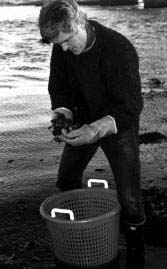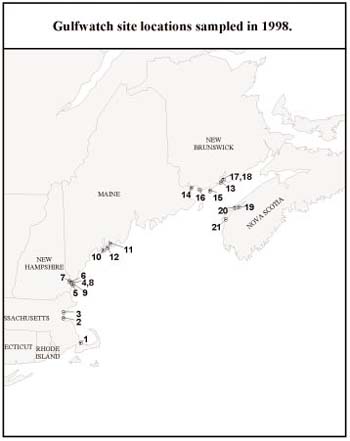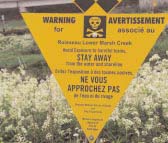
![]()
Volume 6, No. 2
Promoting Cooperation to Maintain and Enhance
Environmental Quality in the Gulf of Maine
|
||||||||||
|
Regular columns |
|
Archives |
|
About |
Q & A with Dr. Stephen Jones
By Theresa Torrent-Ellis
For more than a decade, scientists and
volunteers around the Gulf of Maine
have been plucking mussels from the
shoreline and examining them to determine
environmental conditions. Under
the auspices of a Gulf of Maine Council
program called Gulfwatch, the mussel
tissues are analyzed for a list of potentially
toxic contaminants, including chlorinated
pesticides, polychlorinated
biphenyls (PCBs) and polycyclic aromatic
hydrocarbons (PAHs). In elevated
concentrations, these types of contaminants
can cause cancer, mutations, neurological
disorders and disrupt endocrine
systems.
Knowing the level and distribution of
certain contaminants in mussels, said Dr.
Stephen Jones, a researcher at the
University of New Hampshire in
Durham and co-chair of the Council’s
environmental monitoring committee,
Tell us about Gulfwatch.
Gulfwatch is a Gulf of Maine Council
supported monitoring program. The
program addresses both public health
and ecosystem quality issues related to
toxic contaminants. It entails monitoring
for trace metals and toxic organic
compounds using blue mussels as an
indicator of the level and extent of contamination
in the Gulf of Maine. The
monitoring is conducted in all five jurisdictions
of the Gulf and all participants
are volunteers. The results have been
published in eight consecutive annual
reports, two scientific, peer-reviewed
articles and translated into fact sheets
and summaries for environmental managers
and the public. The data and most
reports are on the Council’s Web site
[www.gulfofmaine.org/library/
gulfwatch/index.html].
Gulfwatch was launched
more than ten years ago.
What were your concerns
at that time?
When beginning to develop the early
projects for the Gulf of Maine Council it
was recognized that toxic contamination
is transboundary and unlike other issues
very little was known about toxic chemicals
on a Gulf-wide basis. Monitoring
for toxic chemicals is an important component
of many monitoring efforts and
Gulfwatch was modeled after the ongoing
NOAA [National Oceanic and
Atmospheric Administration] Mussel
Watch program.
What is Gulfwatch
focused on today?
Gulfwatch is looking at a suite of priority
contaminants which are either persistent
in the environment or can cause
unwanted effects if present at high
enough concentrations. These contaminants
can be harmful to humans through
the consumption of seafood or toxic to
other organisms through exposure in the
marine environment. Gulfwatch provides
information that shows whether
these contaminants are present at levels
above what are natural conditions, as a
result of human activities.
Could you give an example
of specific contaminants
of concern at this
time?
Mercury still has numerous active
sources in the Gulf of Maine, the most
significant of which is atmospheric deposition.
As a result of this source, mercury
is found at elevated levels at many sites
around the Gulf of Maine. Having mercury
concentration information for blue
mussels allows scientists to incorporate
this data from the marine environment
with that from freshwater environments
–lake water, loons and fish–into
their models to provide a more comprehensive
assessment of mercury impacts
and dynamics in the whole Gulf of
Maine ecosystem.
Other contaminants of immediate
concern are those that are listed in the
warnings for human consumption of
seafood, including PCBs and dioxin.
Have any of the contaminants
monitored for
decreased in concentration?
Since 1991, we have been analyzing
mussel tissue for ten different heavy
metals and four types of toxic organic
contaminants at over 60 sites. The sites
vary from Boston Harbor to sites in
Maine far from any human activities.
Thus, it is difficult to make general
statements about decreasing contaminant
concentrations across the whole
Gulf of Maine. We have seen both
increases and decreases of all the contaminants
at different sites within the
ecosystem. When looking at all the contaminants
and all the sites over time the
results show that there have been more
decreases than increases.
What have been the five
major successes for the
first ten years of
Gulfwatch?
The first is simply the fact that we
overcame the logistical challenges in
establishing a multi-jurisdictional,
national and international effort.
Second, we have successfully maintained
participation and financial support
for 11 years. Third is the ability to
provide useful information to public
health officials and environmental managers
throughout the Gulf of Maine.
Fourth is that we have been able to
establish a Gulf-wide baseline of contaminant
concentrations as well as to draw
attention to sites where contaminants
are present at higher concentrations.
And finally, that we have drawn local,
jurisdictional, national and international
recognition as an important regional
monitoring effort.
Theresa Torrent-Ellis is the outreach
and education coordinator for the Maine
Coastal Program/Maine State Planning
Office.
can help scientists, government agencies,
businesses and environmentalists in
developing regional plans and programs.
Along with providing baseline data, the
information also helps determine if and
how water quality in a particular area has
been affected by a specific occurrence
such as an oil spill.
In a recent interview, Jones said that
the diversity of the Gulf’s
coastline–spanning from urban to
rural–makes it impossible to draw a generalize
picture of the levels of contaminants
in the region. However, he added,
since the program began, scientists have
seen an overall decrease in some contaminants
from the 60 sites sampled. In the
following excerpt, Jones talked about the
evolution of Gulfwatch, some of its findings
and concerns.

Stephen Jones with blue mussels
Photo: Suzy Fried

A snapshot of Gulfwatch findings in
its latest review of contaminants in the
Gulf, Evaluation of Gulfwatch 1998:
Eighth year of the Gulf of Maine
Environmental Monitoring Plan (published
in December, 2001, by the Gulf of
Maine Council):
The Gulfwatch contaminant checklist
Inorganic contaminants
Heavy Metals |
Heavy metals are persistent environmental contaminants–meaning they cannot be degraded or destroyed. They tend to accumulate in soils, seawater, freshwater and sediments. Excessive levels of metals in the marine environment can affect marine life and pose risk to human consumers of seafood. Sources include various industrial activities such as present and former mining activities, foundries and smelters and diffuse sources such as piping, combustion byproducts and automobile emissions. Several heavy metals, like cadmium, lead and mercury are highly toxic at relatively low concentrations and can accumulate in body tissues over long periods of time. |
Organic Contaminants
Polycyclic Aromatic Hydrocarbons PAHs) are present in low concentrations virtually everywhere. Elevated concentrations of PAHs can occur from prolonged industrial burning or by release of materials such as creosote-based wood preservatives, which contain PAHs in high concentrations. Sources include power plants, domestic heating systems that burn oil, coal or wood, gasoline and diesel engines, waste incineration, various industrial activities and tobacco smoke.
Chlorinated Pesticides (TPESTs) are man-made organic chemicals that have been used to control everything from fungus to grasshoppers. DDT was the first that was used on a large scale in North America; it was heavily applied in agricultural regions. Most organochlorine pesticides have been banned in Canada and the United States, but are still routinely found in air and precipitation.
Polychlorinated Biphenyls (PCBs) are a group of over 200 man-made chemicals. They are extremely persistent compounds. Because of their insulating and fire-resistant properties, mixtures of PCBs were commonly used as coolants and lubricants in heat exchangers, pumps, electrical transformers and capacitors. Older electrical equipment and fluorescent lighting fixtures still in service may contain PCBs. The manufacture of PCBs in the United States and Canada has been banned.
 A warning sign near Marsh Creek in Saint John, New Brunswick. The creek has been contaminated with polycyclic aromatic hydrocarbons, chemicals found predominantly in petroleum-based products like creosote. |